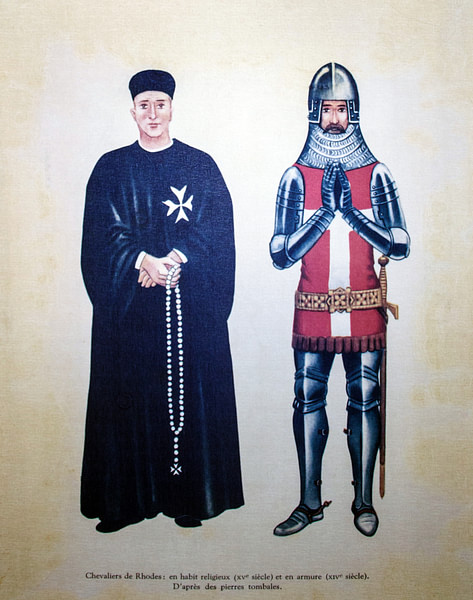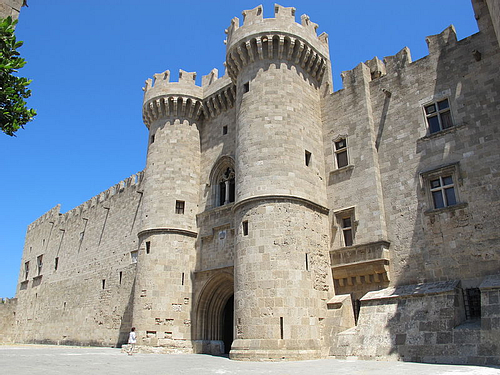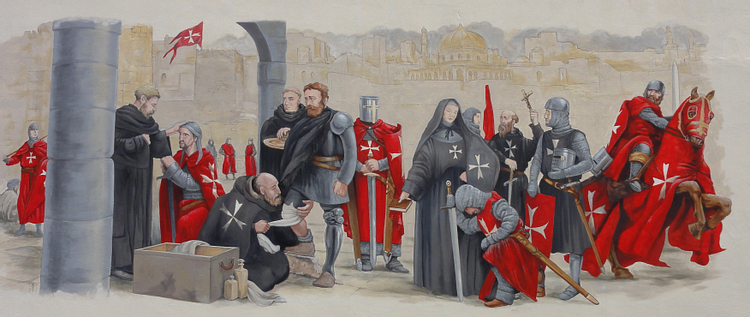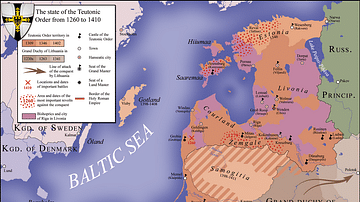
The Knights Hospitaller was a medieval Catholic military order founded in 1113 CE with the full name of 'Knights of the Order of the Hospital of Saint John of Jerusalem'. After their base was relocated to Rhodes in the early 14th century CE, the order's members were often called the Knights of Rhodes and when they moved again in 1530 CE, this time to Malta, they were subsequently known as the Knights of Malta. The original purpose of the order was to provide aid and medical care to Christian pilgrims to the Holy Land, but it soon became a military order which acquired extensive territories in Europe and whose knights made significant contributions to the Crusades in Iberia and the Middle East. The Knights Hospitaller, identified by their distinctive white eight-pointed cross on a black background, participated in many other campaigns besides, notably those involving the Byzantine Empire. The order still exists today in several modified forms in many countries worldwide, ranging from the Roman Catholic Sovereign Military Order of Saint John to the volunteer Saint John's Ambulance Brigade.
Foundation & Independence
The order was first established at the Hospital of Saint John in Jerusalem c. 1080 CE (or even earlier) by a group of merchants from Amalfi in Italy. The John it was originally dedicated to was the 7th-century CE patriarch John the Almsgiver, but he was later replaced as patron by the more universally known and more popular Saint John the Baptist. At the hospital, which had two branches - one for men and another for women, charitable aid was offered to pilgrims in the Holy Land, especially the ill and poor, although there were even some non-Christians amongst its patients. The hospital was run under the auspices of the Benedictines monks of the Latin Church of Santa Maria Latina in Jerusalem and then, in 1113 CE the organisation was officially recognised as a religious order by Pope Paschal II (r. 1099-1118 CE). In the same year, its first master, the Blessed Gerard, was officially appointed and its members recognised as monks. Following the capture of Jerusalem by western armies in the First Crusade (1095-1102 CE), the order was reorganised and made more militaristic from 1120 CE by the then master Raymond du Puy. Between 1135 and 1154 CE the church granted the order independence from any local religious authority.
The Hospitallers, as they would become known, eventually ran most of the hospitals in the Holy Land and even started to build them in Europe, one of the earliest being in Utrecht in 1122 CE. The hospital at Jerusalem was, of course, the most famous, and its 75 x 40 metre (250 x 130 ft) building could accommodate over 1,000 patients. Such was the respect from the Muslims for the institution that even when Saladin, Sultan of Egypt and Syria (r. 1174-1193 CE), conquered Jerusalem the Hospitallers were allowed a year to shut it down and move patients away.
The gradual establishment of command posts (commanderies) across Europe ensured the order a steady supply of funds, materials and recruits. Generally, the outposts fed one-third of their revenue back to the order's headquarters. By the second half of the 12th century CE, the order had established itself as a reliable source of well-armed and well-trained knights immensely useful to Crusader armies and the newly established Christian states of the Latin East.
Organization & Recruitment
The leader of the order was the Master who was elected by a committee of brother knights and who held the position for life. The next most important position was that of Grand Commander, the man responsible for administration, supplies, and weapons. The Marshal looked after all military and disciplinary affairs. Other senior officers included the Constable who commanded the knights (of which there were several hundred at any one time) and the much larger number of mercenaries the order regularly employed, the Admiral who commanded the order's ships (mostly based at Marseilles and Cyprus), the Master Esquire in charge of horses, the Gonfanonier or standard-bearer, and the various Castellans, the individual commanders of the larger Hospitaller castles. High-ranking non-military brothers included the Conventual Prior - the most senior ecclesiastical figure, the Hospitaller - chief of the hospitals -, and the Treasurer. Below these figures were a vast army of administrators looking after everything from clothes to the funerals of brothers.
In the 12th century CE, France proved an especially fruitful recruiting ground and the order came to be dominated by warriors from that region. The Hospitallers were also popular in Bohemia and Hungary where, as elsewhere, any young man keen for a mix of monastic living and military adventure could join. Although no particular social status was required, criminals, those in debt, or ex-members of other military orders could not join. Recruits were expected to live a life of piety, chastity, obedience, relative poverty, and to eat and sleep communally.
From the 13th century CE, recruitment became more selective with a definite preference for aristocrats who could also provide the order with the necessary funds for expensive arms and armour. Eventually, only a descendant of a knight could become a knight of the order. Brothers wore a black robe or mantle which had a white eight-pointed cross on it. Coloured clothing and animal skins were forbidden. From the 13th century CE, knights and sergeants wore a scarlet surcoat or tunic when in battle.
As in other military orders, minors could join as novitiates and receive training over several years to become full brothers, although the Hospitallers were known for giving less attention to general education, with the result that many recruits remained illiterate. Besides knights, there was the lower category of sergeants, the even lower class of servants, and, of course, those who were purely priests and never raised a sword in anger. Once in the fold and having sworn allegiance to the Master, it was very difficult to get out, although buying one's freedom was possible, if scandalous.
Besides income from new recruits and cash donations, the order generated money from the estates it owned, olive oil and sugar cane being notable profit-makers. In addition, merchants were compelled to pay levies when passing through Hospitaller-held territories. War booty and the acquisition of slaves were not insignificant contributors to the Master's coffers either. The order was continuously boosted by the acquisition of properties and materials either by force, donation or their abandonment after warfare so that the Hospitallers, although never quite as rich as their reputation promised amongst outsiders, were able to profitably manage farms, monasteries, markets, bakeries, mills, and inns all over Europe and the Middle East.
The Crusades
The Hospitallers, like other orders such as the Knights Templar, provided a vital few hundred knights to western Crusader armies, especially from the Third Crusade (1187-1192 CE) onwards when they often formed the flanks of armies on the battlefield. Indeed, the great Muslim leader Saladin offered a bounty to any man who took a Hospitaller prisoner; such was their importance to the Crusader armies. The order also continued its important role in offering medical attention to those who needed it.
One of the first castles given to the order to help fulfil its function of protecting Crusader-held territory in the Middle East was Beth Gibelin (aka Bayt Jibrin) near Jerusalem in 1136 CE by King Fulk of Jerusalem. They famously had a garrison at Krak de Chevaliers, the massive castle in Syria given to the order in 1144 CE, which they extensively remodelled (it fell to the Mamluks in 1271 CE). Another important Hospitaller castle in Syria was Marqab (aka Margat), in the order's hands from 1186 CE, and to which they added the massive tower keep. In all, the Hospitallers came to control some 25 castles in the Middle East, many of which guarded important coastal areas and land routes.
The Hospitallers were a key component of the Fourth Crusade (1202-1204 CE), and although they were involved in the unsuccessful defence of Acre in 1291 CE, the order was credited with helping many refugees escape to the safety of Cyprus. Regular campaigns followed against the Ottoman Empire from the 14th century CE. In 1344 CE the Hospitallers were part of the Papal League which captured Izmir, and in 1365 CE they attacked Alexandria. There were also many setbacks, notably the disastrous invasion of the Despotate of Epiros (1376-1381 CE) and the defeated Crusade of 1396 CE. For the Hospitallers, though, they would prove to be resilient enough to survive the catalogue of failures of the later crusades and they continued to enjoy their status as a powerful international agency of profit and war.
Relocation: Rhodes
When Jerusalem fell once again into Muslim hands in 1187 CE and the Crusaders were forced to withdraw, the Hospitallers moved their base, first to Acre in 1191 CE, and then, when the Latins were kicked out of the Holy Land altogether in 1291 CE, the Knights Hospitaller moved to a new headquarters on Cyprus. Unfortunately, the island lacked a sufficiently good harbour and the land was not as fertile as hoped. Consequently, in 1306 CE, the Hospitallers decided on the island of Rhodes as their permanent base, but they would first have to capture it from the Byzantines.
Once won, Rhodes was fortified with the strongest defences in the Mediterranean in 1309 CE. Rhodes would be the Hospitaller's headquarters until its capture by the Ottomans in 1522 CE and provided a handy base for passing western armies on their way to the Middle East. The island, just as it had always been since antiquity, was of great strategic importance in the Mediterranean. Rhodes' Greek Orthodox population, viewed by the Catholic Hospitallers as schismatics, was compelled to recognise the supreme authority of the Pope and, in the capital, Greeks were forcibly moved to the suburbs. The old palace was extended, the knights lived in comfortable quarters arranged in groups based on the brother's first language, and, of course not forgetting the order's origins, there was a well-appointed two-storied hospital which still stands today after being restored and used by the Italians during the First World War.
Another consequence of the move to Rhodes was that it led to the Hospitallers becoming much more of a naval-based military order. Treated as second-class citizens, many of the locals would end up as rowers in the order's galley ships. Thanks to the relocation, too, from 1310 CE, members were often now referred to as simply the Knights of Rhodes. Despite the tensions, though, Rhodes prospered under Hospitaller rule and, while the Ottoman Empire spread ever wider, the island remained one of the last Christian outposts in the Aegean. By the mid-15th century CE, the Hospitallers could boast some 450 knights and 2000 militia on the island. Further afield, the Hospitallers continued to manage a network of priories across Europe, and the order was further boosted by the demise of the Knights Templar, whose properties were given over to the Hospitallers in 1312 CE.
The Hospitallers & the Byzantine Empire
The Hospitallers had a close relationship with the Byzantine Empire. With an outpost in the capital Constantinople, Emperor Manuel I Komnenos (r. 1143-1180 CE), for example, employed the order's prior as a diplomatic envoy. The order helped to restore John V Palaiologos (r. 1341-1391 CE) to the throne and received the gratitude of his son and successor Emperor Manuel II (r. 1391-1425 CE). Then, as the Byzantines continued to struggle to hold on to their empire, Corinth in the Peloponnese of Greece was sold off to the Hospitallers in 1397 CE, although they only held onto it until the Ottomans conquered the region in 1403 CE. Perhaps in response to the gift of Corinth, practical military assistance was provided when the knights joined Manuel II's campaign against the Ottomans and their fortress at Riva on the Black Sea in 1399 CE.

The Hospitallers' independence and close relations with the Byzantines was probably one of the reasons they often received criticism from Popes and other western leaders. Their perceived wealth was another source of jealousy. The criticisms included being extravagant in their clothes and lifestyle, too ruthless in their treatment of Muslim prisoners, too liberal in their promotion of lower class men to the rank of knight, and even shameless protectors of pirates. The latter claim had some justification as the Hospitallers relentlessly pursued their strategy of making the Mediterranean shipping routes a continuous war zone by attacking anything that floated in range. Other military orders, especially the Templars and Teutonic Knights, received similar criticisms, and it was a sign that in the late medieval period states were increasingly wary of these dangerous elite warriors who were a law unto themselves.
Relocation: Malta
The Ottomans, eager to once and for all remove the Christian thorn from the Mediterranean flank of their empire, attacked Rhodes in 1455 CE and again in 1480 CE. It was to be third time lucky in 1522 CE, and the Hospitallers were, once again, obliged to look elsewhere for their permanent headquarters. After brief pauses on Sicily and on the Italian mainland, in 1530 CE, the order this time chose Malta as their new home, given to them by the King Charles V of Spain (1516-1556 CE). Thus, the members were now referred to as the Knights of Malta. The Ottomans followed them there, too, but this time the attack was rebuffed in 1565 CE. Malta was not so great for agriculture, only cotton and cumin being notable sources of revenue, but the island did have one of the best harbours in the Mediterranean. Quite what the 12,000 Arab-speaking peasantry on Malta (and the 5,000 on neighbouring Gozo) made of their new overlords we can but imagine.
The 16th century CE also saw the Hospitallers on campaign against the Moors in North Africa, but the general health of the order was in decline. The wave of religious fervour brought on by the Crusades was long since passed and recruitment became a problem. Indeed, in such places as the Iberian peninsula, the order became embroiled in conflicts between rival Christian kingdoms. The old days of a holy war against a clearly identifiable enemy of Christianity and the prospect of a surer place in heaven for those who fought them was over. So too, the management of the vast network of estates across Europe was far from efficient, and a lack of proper supervision led to widespread corruption, nepotism, and wastage of funds and resources. With the disappearance of the very reasons why the order had been established in the first place, a transformation was inevitable.
The Hospitallers, and their island retreats of Rhodes and then Malta had lasted longer than anywhere else as bastions of medieval chivalry, but eventually, even there, modernity caught up with the order. Even the order's role as a provider of hospitals was largely superseded by institutions run by local councils and the Hospitaller's traditional role as a guardian of pilgrims was less in demand as fewer and fewer westerners made the long and arduous journey to the Muslim-controlled Holy Land. Still, the order soldiered on until Malta was captured by Napoleon in 1798 CE, and it still exists today in various forms in various countries, from medal-awarding chivalric orders to volunteer ambulance services, the latter, of course, continuing the Hospitallers original purpose of giving free medical aid to those most in need.







